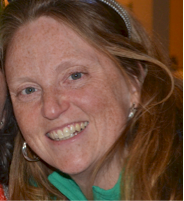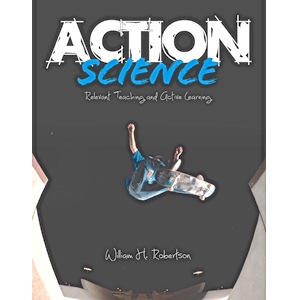Making Science Relevant in the Middle Grades
Action Science: Relevant Teaching and Active Learning
By William H. Robertson
(Corwin, 2014 – Learn more)
 Reviewed by Hallie Askuvich
Reviewed by Hallie Askuvich
William H. Robertson channels his unique perspective and experiences as a skateboarder and educator into a well-written, informative and enjoyable read in Action Science: Relevant Teaching and Active Learning.
Action Science can be defined as the use of familiar objects, circumstances and situations within students’ lives to explain specific concepts in science built around student interests, including action sports such as skateboarding and bicycle motocross.
 As a former middle school teacher I had to restrain myself from diving right into the Action Science Classroom Activities outlined in Chapter 8, and I was glad I did! Action Science is a well-researched book that cohesively addresses constructivist theory, the 5E instructional model, and physics concepts in a manner that embodies the spirit of the Next Generation Science Standards (NGSS). As Robertson says himself,
As a former middle school teacher I had to restrain myself from diving right into the Action Science Classroom Activities outlined in Chapter 8, and I was glad I did! Action Science is a well-researched book that cohesively addresses constructivist theory, the 5E instructional model, and physics concepts in a manner that embodies the spirit of the Next Generation Science Standards (NGSS). As Robertson says himself,
This book is grounded in the implementation of constructivist teaching and learning methodology that centers on a teacher providing students with an experience and then sharing the content of what they will learn after completing an activity, discussing ideas, and being immersed in the content in a hands-on manner.”
Robertson takes the notion of constructivism even further by suggesting that transformative learning theory need not be specific to teacher professional development, but rather can also serve the needs of middle school students—especially those that have been marginalized or that are typically challenging to engage in academics. After all, who wouldn’t want to do an assignment that involves collecting data at the skatepark!
Action Science is divided into the following eight chapters:
Chapter 1: What Is Action Science?
Chapter 2: Constructivism and the Classroom Teacher
Chapter 3: Making Science Relevant in the Middle Grades
Chapter 4: Linking Pedagogy and Science Content in Practice
Chapter 5: Using the 5Es in Action Science
Chapter 6: Unlocking Resources for Active Learning
Chapter 7: Action Science and the Future
Chapter 8: Action Science Classroom Activities
Throughout all of the chapters, Robertson provides multiple examples of the alignment between the NGSS and inquiry learning. He provides resources in the classroom activities as well as the video clips available on his website Dr. Skateboard and the QR codes (although these were unfortunately lost on me as I have not yet caved and purchased a smart phone).
While Action Science lays a nice foundation for inspiring teachers to embark on the instructional shifts necessary to truly engage students in meaningful, integrative, and relevant learning experiences around physics concepts, there are a few areas in which additional support may be needed for many teachers. For example, while using the Internet as a platform for students to “go public” with their thinking is a wonderful idea, many teachers still need support around how to manage this with their students. Additionally, as Robertson states,
Action science is a way for teachers to adopt an attitude of relevance and to seek out content that connects to the students not merely to recycle the lessons and activities they have used each year without revision and, in many ways, in constant repetition irrespective of students learning styles or individual strengths and weaknesses.”
This is a shift for many that requires confidence and a willingness to take risks for the benefit of the students. That being said, this book in conjunction with professional development or as part of a professional learning community (PLC) would certainly serve as a transformative educational experience. Furthermore, I would like to see versions of Action Science for the life and earth sciences in the future!
Hallie Askuvich is a National Board Certified Teacher in Early Adolescent Science and currently teaches Science Methods at Northeastern Illinois University and is the Middle School Science Specialist in the Department of Science for Chicago Public Schools (CPS) where she leads professional development and contributed to the development of the CPS Science Content Framework. Hallie has been with Chicago Public Schools for 14 years as a middle school classroom teacher, a Citywide Science Specialist, and an Area Science Coach.


































